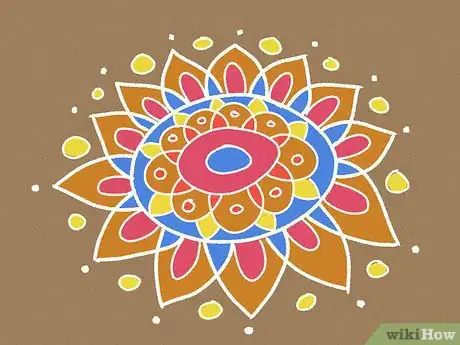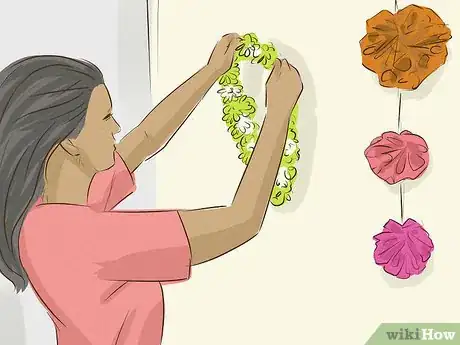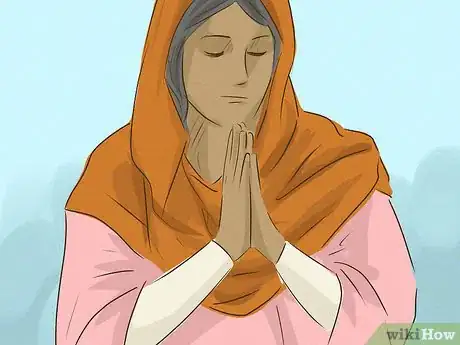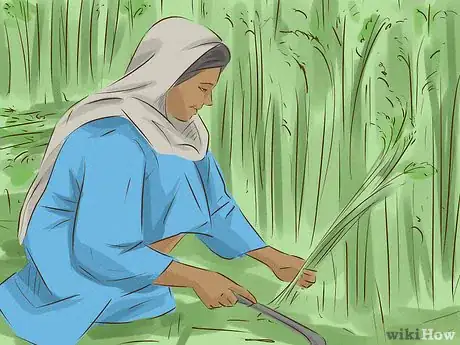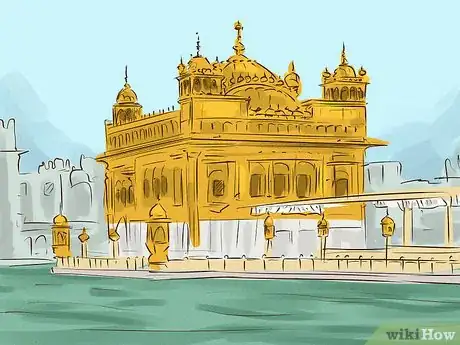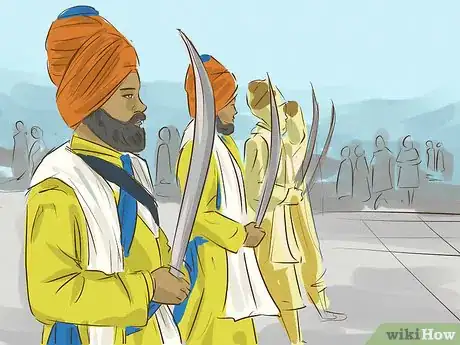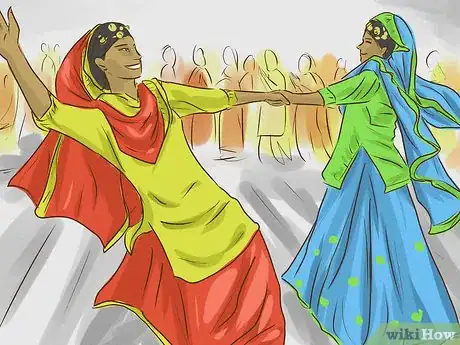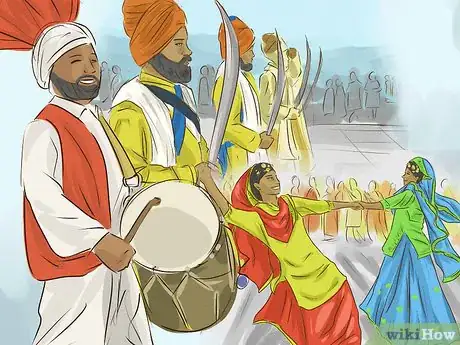This article was co-authored by wikiHow Staff. Our trained team of editors and researchers validate articles for accuracy and comprehensiveness. wikiHow's Content Management Team carefully monitors the work from our editorial staff to ensure that each article is backed by trusted research and meets our high quality standards.
There are 11 references cited in this article, which can be found at the bottom of the page.
This article has been viewed 38,103 times.
Learn more...
Also spelled Vaisakhi, Baisakhi is the Sikhi New Year celebration that takes place every year on April 13 or 14. A joyous, vibrant event, it’s also the spring harvest festival, where Sikhs rejoice in the abundance of crops and pray for future good fortune. The biggest celebrations occur in Punjab, India (the birthplace of Sikhism) and include feasts, parades, prayers, and plenty of socializing. Even if you aren’t in India, many Sikh communities around the world put on events in their area to celebrate Baisakhi.
Steps
Decorating Your Home
-
1Incorporate red, orange, and yellow hues into your decor. Baisakhi is celebrated with vibrant colors and these three carry the most meaning for the holiday.[1] Hang yellow curtains, toss bright red pillows onto the couch, or lay out an orange rug in the hallway.
- Orange and yellow are considered the official colors of Sikhism. They signify the sacrifice that the original disciples (the Panj Piaras) made for their beliefs.
-
2Draw a rangoli design at the entrance to your house with colored powder. These drawings welcome guests and good fortune into your home. Sweep the porch or entryway, then use your fingers to spread the rangoli powder in a pretty design or symbol.
- In addition to the powder (or in place of), you can use chalk, colored rice, sand, flour, or even petals.[2]
- Rangolis are often symmetrical, geometric designs with a variety of curves, lines, and shapes. You can make your rangoli as simple or as intricate as you'd like.
- Buy rangoli powder from specialty Indian stores, online from retailers like Amazon, or in stores like Walmart.
Advertisement -
3Drape bright flower garlands around your house. Flowers, particularly garlands, play a huge role in Indian culture as they're a sign of respect to guests and higher beings.Choose garlands that are made with jasmine flowers which not only smell nice, they also represent auspiciousness and prosperity.
- Giving garlands to guests is a common practice in India.
- A good spot to hang garlands is above the door to your house, welcoming your guests as they enter.
Partaking in Religious Rituals
-
1Wake up early to take a bath in a nearby pond or river. People in India will bathe in the holy Ganges River in honor of the Goddess Ganga. Baisakhi is believed to be the day when the goddess came down to Earth.[3]
- Baisakhi is also a popular day for new Sikhs to be baptized as it’s a holiday centered around brotherhood.
- If you don't have access to a pond or river, you can simply bathe in your own tub! The point is that you are rinsing off your sins and starting fresh.
-
2Dress in orange or yellow clothing that's never been worn. After you bathe, you should put on brand new clothes to signify the start of a new year. Orange and yellow symbolize both rebirth and celebration.[4]
- A bright yellow also mirrors the golden wheat being harvested during the festival.
-
3Pray at a gurdwara, thanking God for an abundant harvest. Gurdwara literally means “gateway to the guru" and is any place of worship that the Sikh holy book is kept. When praying during Baisakhi, Sikhs often ask for good luck and prosperity in the year ahead.
- During these prayers, the holy book is placed on a ceremonial throne.
-
4End your prayer at the gurdwara with langar. Langar refers to the common kitchen where food is served in a Gurdwara to all the visitors for free. At the Langar, only vegetarian food is served to ensure that all people, whether Sikhs or Non-Sikhs, regardless of their dietary restrictions, can eat as equals. This feast is the Sikh version of American Thanksgiving, and boasts all of the delicious crops that were harvested in the recent season. At the temple, volunteers will serve you traditional Punjabi cuisine like makki di roti (a cornmeal flatbread), saag, and vegetarian curry.
- They will serve anyone, no matter your race, religion, or caste.
-
5Help harvest wheat at Awat Pauni. In farming communities, everyone heads to the fields to help the farmers collect the crops. This includes men, women, and children. Dhol drums beat in the background and people often sing dohas (poems) and folk songs together while they work.[5]
-
6Visit the Golden Temple to worship where Khalsa was founded. Khalsa (which means “pure”) is the sect of Sikhism where its followers are baptised through the Amrit Ceremony.[6] Traveling to the Golden Temple in Amritsar is a goal for most Sikhs. It’s considered their religion’s most sacred place.
- During Baisakhi, water from India’s holiest rivers is poured into the pools surrounding the Golden Temple. Visitors are allowed to take a dip in the water which is thought to have miraculous powers.[7]
Enjoying the Festivities
-
1Attend a Nagar Kirtan parade led by Panj Piaras. Usually 5 senior Sikhs in traditional dress, they represent the original Panj Piaras ("Five Beloved Ones"), who were the first disciples of the Sikh’s Khalsa Panth. Marching behind them will be dhol drummers, dancers, and floats with people singing hymns from the Sikh holy book, the Granth Sahib.
-
2Watch the bhangra and gidda dances after the parade. These popular traditional folk dances are done in groups to the beat of dhol drums. Men perform the bhangra and women perform the gidda. Dancers stand in a circle. Usually in pairs, they each rotate into the center when it’s their turn, performing a short verse. The verses blend harvesting motions (like sowing seeds or collecting crops) with energetic dance movements[10] [11]
- Bystanders are allowed to enter into the dance circle if they’d like.
- Because of the constant rotating in and out of the circle, bhangra dances can last for hours.
-
3Go to a Baisakhi Fair for folk music, dancing, crafts, food, and more. Also known as Baisakhi Mela, these incredibly lively events are one of the highlights of the whole festival. Listen to the sounds of traditional instruments like vanjli and algoza while you browse the vendors selling knick-knacks and delicious Indian food.[12]
- There are also plenty of exciting performances from races to wrestling to adrenaline-pumping acrobatics.
-
4Exchange gifts with friends and family. Since Baisakhi is so rooted in community and relationships, Sikhs tend to spend a lot of time with their loved ones during the day and often give gifts to each other. These gifts often include a box of sweets, particularly laddoos, which are tiny treats made with flour, dried fruit, and nuts.
References
- ↑ http://www.worldsikh.org/what_is_the_significance_of_the_orange_and_yellow_colours
- ↑ http://www.louisianafolklife.org/LT/Articles_Essays/rangoli.html
- ↑ https://indianexpress.com/article/lifestyle/art-and-culture/when-is-baisakhi-2017-date-history-celebrations-significance-4610824/
- ↑ https://www.birminghammail.co.uk/whats-on/whats-on-news/why-is-vaisakhi-festival-celebrated-14390465
- ↑ http://www.india.com/news-travel/baisakhi-2017-how-is-baisakhi-celebrated-in-punjab-3230242/
- ↑ https://www.sikhs.org/khalsa.htm
- ↑ http://www.baisakhifestival.com/celebrations-in-golden-temple.html
- ↑ http://www.bbc.co.uk/religion/religions/sikhism/holydays/vaisakhi.shtml
- ↑ https://www.birminghammail.co.uk/whats-on/whats-on-news/why-is-vaisakhi-festival-celebrated-14390465

